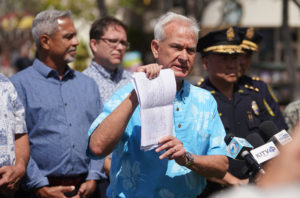City Leaders Unveil Most – But Not All – Of Future Rail Operations Costs
The new 13-year, $918 million deal with Hitachi is nearly $100 million more than the one signed in 2011. It will cover just over half of the costs to run the rail system.
Honolulu city leaders offered a clearer picture Wednesday — although not a full one — of how much it will eventually cost to operate and maintain the island鈥檚 rail transit system.
At a press conference led by Mayor Kirk Caldwell, they announced they’d signed an updated $918 million deal with Hitachi Rail Honolulu JV to run the rail line and its driverless trains for the first 13 and 录 years in service.
Caldwell and other transportation officials said the agreement made last week will cover the bulk of rail鈥檚 operating costs for more than a dozen years. They stressed that it gives the public its first solid look at how much it will actually cost to run the system.
“What we’re talking about today is a known contract, where we fixed the number, we’re obligated to pay — and they’re obligated to deliver,” Caldwell said Wednesday.

Once more passengers start riding the train, transit officials hope fare revenues will help taxpayers recoup at least a quarter of that $69 million per year.
鈥淚t鈥檚 a nut that we can cover鈥� with the city鈥檚 budget, Caldwell said.
It鈥檚 hardly the entire rail operations cost, however.
The Hitachi portion excludes electricity, security, administrative oversight and other so-called 鈥淥&M鈥� components needed to keep the elevated transit system running.
Under rail鈥檚 , the power costs alone would come to about $19 million in the first year operating the full rail line to Ala Moana.
Administration, meanwhile, would cost about $8 million that year. Security would cost nearly $3 million.

All told, it’s expected to cost nearly $127 million to run the full 20-mile, 21-station rail line in its first year, according to the recovery plan. That’s nearly twice as much as the $69 million Hitachi figure touted Wednesday.
Wes Frysztacki, Caldwell鈥檚 transportation services director, said they would unveil a detailed picture on those additional operations costs next week as part of the annual budget process.
“We’ll have the full cost of operating rail for the city in that budget and it will be in extraordinary detail,” added Frysztacki. “I don’t think we want to get into that Q&A right now.”
‘A Lot Of Different Assumptions Had To Be Updated’
The revised, $918 million deal over 13 years is nearly $100 million more than what the city agreed to in 2011 with Ansaldo Honolulu JV, which later became Hitachi Rail.
with Ansaldo included 鈥渁 lot of different assumptions that had to be updated,鈥� said , a longtime Honolulu transit official who now works on contract as the city’s operations and maintenance interface manager.
Basically, Garrity is helping the city prepare to run rail once HART hands the system over.
Under the revised deal 鈥渨e鈥檙e actually getting better service, we鈥檙e actually having more people show up and work at each of the stations,鈥� Garrity added. 鈥淭he original contract did not have a station attendant at each station. So we鈥檙e having some additional or improved services.鈥�
Furthermore, HART’s decision to run contributed to the added cost, Garrity said.

The $830 million deal was part of a larger, $1.4 billion contract to have Ansaldo design build operate and maintain the rail line鈥檚 driverless trains plus its communications and signaling system — 鈥渢he brains and the trains,鈥� as rail officials sometimes described it.
It was the largest public contract awarded in Hawaii to that point.
Meanwhile, HART and the city expect to lump Hitachi’s new $918 operations million deal into the public-private partnership, or “P3,” that they hope will finally get rail finished.
 Sign up for our FREE morning newsletter and face each day more informed.
Sign up for our FREE morning newsletter and face each day more informed.
That proposed partnership includes a construction component to build rail’s final four miles into town and a transit hub at Pearl Highlands.聽 But at the bidders’ request, it includes a 30-year operations component as well to run the system.
Hitachi, officials said, would essentially become a subcontractor to the venture that wins the P3 bid. When Hitachi’s 13-year contract is up, that venture could continue with Hitachi or choose someone else, Garrity said.
Wednesday’s announced deal gives the P3 bidders more clarity as they finalize their proposals, Caldwell said. HART expects to get those bids in April and announce an award in May.
We need your help.
Unfortunately, being named a聽finalist for a聽Pulitzer prize聽doesn’t make us immune to financial pressures. The fact is,聽our revenue hasn鈥檛 kept pace with our need to grow,听.
Civil Beat is a nonprofit, reader-supported newsroom based in 贬补飞补颈驶颈. We鈥檙e looking to build a more resilient, diverse and deeply impactful media landscape, and聽we hope you鈥檒l help by .
About the Author
-

Marcel Honor茅 is a reporter for Civil Beat. You can email him at mhonore@civilbeat.org

